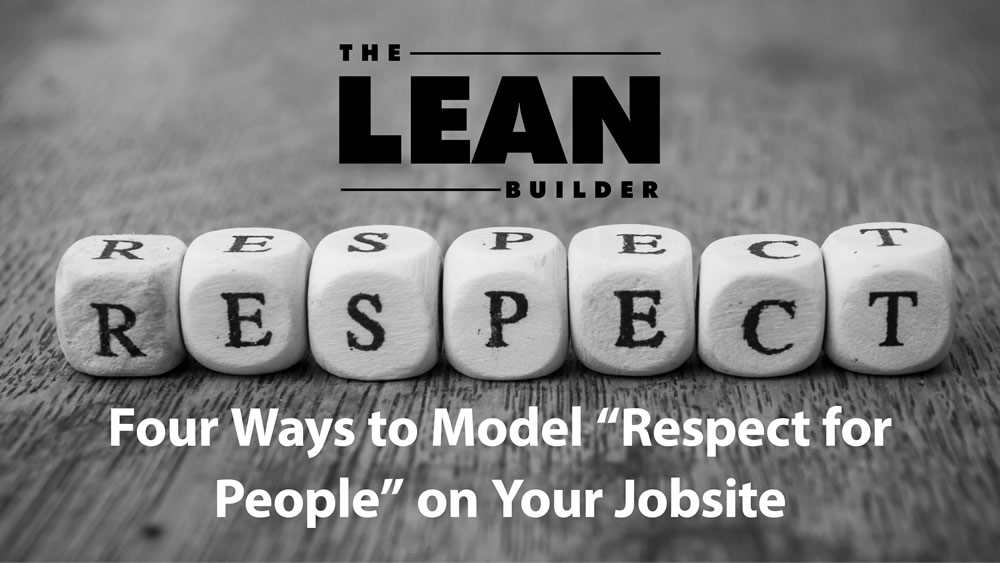Respect for people is at the core of Lean construction. Every step in the Last Planner System® is designed to respect everyone involved in a project by removing waste, improving processes and flow, generating greater value, enabling continuous improvement, and optimizing the whole. Key to fulfilling these goals is creating a jobsite that reflects respect for people in every aspect. This goes beyond simply how people on site treat one another, and encompasses the whole experience of working on a particular site.
Respect for People
Read on for four tips for modeling respect for people on site that you can implement immediately.
1. Keep it clean
Conditions on site reveal a lot about the way workers will be treated — and treat one another — on that project. A clean, neatly organized site with materials stored properly and safety hazards minimized signals a culture of safety and respect. On the flip side, a debris-strewn project is indicative of a negligent management style that hasn’t created a culture of accountability. Tripping hazards, piles of materials, unclean or inadequate restrooms, and litter are all red flags of a lack of respect.
“A lack of cleanliness is an indication of major problems onsite. And conversely, a clean job site is the first indicator of health and stability,” says Jason Schroeder, president of Elevate Construction.
“If you show up to a jobsite and it’s unclean, you can bet the project has major problems. The super doesn’t know how to run a project; there’s no teaming with the trade partners and Last Planners®; there’s a failing and toxic culture onsite; the leaders don’t care about the environment the workers are in daily; there is wimpy leadership at the top, and as a result people’s loved ones are disrespected daily on that project,” Schroeder explains.
2. Run on time
One of Lean construction’s purposes is to facilitate the on-time completion of projects. This isn’t possible without all the steps along the way also happening as planned. This is why many Lean project leaders are sticklers for punctuality. Steve Turner, superintendent and director of Lean improvement at FPI Builders, explains the reasoning behind the standard he enforces.
“Most of our daily huddles start either eight o’clock in the morning or nine o’clock in the morning on our job sites. If we’re at a job site trailer, the trailer door is locked. If you’re one minute late, you’re late for the meeting and that’s just too bad. You can beat on the door all day long, but there has to be a precedent. There has to be a standard set by which these guys are held accountable. Just like me. If I’m one minute late, I would not expect for them to let me in the meeting. There has to be a set of standards there that everybody is going to conform by. And once they understand that, once it’s understood, then they get in line pretty quick. You’re either five minutes early or your late in one of our meetings.”
3. Be open-minded
Respect for people is central to generating support for Lean construction practices. Simply forcing Lean on a team or a project defeats the purpose, which is to empower each individual to make improvements in their work that benefit themselves as well as others. “Lean is a collaborative effort, because you need trust and honesty for this thing to work,” says Mike Poole, senior continuous improvement manager at Barton Malow.
Understanding the viewpoints of different team members and addressing their concerns ensures that they feel respected and makes them more open to hearing your perspective, particularly if you’re trying to implement change. “Everyone hates the word ‘change.’ I like the word ‘evolution.’ This is an evolution of our business to make it better,” says John Zachara, vice president at Integrated Facilities Solutions.
“Diversity of thought is really huge, we have to just continue learning and growing and building on what we’ve been able to accomplish so far,” explains Rebecca Snelling, Lean leadership coach at RS Consulting.
4. Seek out improvement
Continuous improvement doesn’t happen on its own, and improvements don’t need to involve major change to be worthwhile. Solicit feedback and ideas from everyone on site and make it clear that input is welcomed. This doesn’t mean you need to take every suggestion, but by creating an environment that’s open to new ideas, you’re more likely to get some good ones.
If you begin to implement these changes on your project, you’re guaranteed to see a shift in on-site dynamics over time. It won’t happen overnight, but with consistent effort you will see a difference — and so will your clients.









